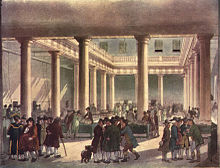Mark Lane, London
 Mark Lane in 2008, viewed from Great Tower Street | |
| Location | London, United Kingdom |
|---|---|
| Postal code | EC3 |
| North end | Fenchurch Street |
| South end | Great Tower Street |
Mark Lane is a street in the City of London linking Great Tower Street and Fenchurch Street. It gave its name to the nearby Mark Lane tube station, which was opened in 1884, renamed Tower Hill in 1964, and closed three years later. For some 240 years, Mark Lane was known for the corn exchange (which was the only market in London for corn, grain and seed); it occupied a series of properties on the east side of the southern end of the street.
Description
[edit]
At its northern end, Mark Lane originates as a two-way side-road off Fenchurch Street, leading to Dunster Court, the home of the Worshipful Company of Clothworkers.[1]
The street plays host to a number of offices and restaurants. The nearest London Underground station is Tower Hill (Circle and District lines) and the nearest mainline railway station is Fenchurch Street (with services towards east London and Essex).[2]
Near the northern end of the lane stood the medieval Church of All Hallows Staining, which was demolished in 1870 when its parish was united with nearby St Olave's Church, Hart Street. Only the 12th or 13th century bell tower survives at the junction with Dunster Court. It is a Grade I listed building.[3]
According to the antiquarian John Stow, writing at the end of the 16th century, the name of the lane is derived from a former cattle market or "mart" once held there.[4]

In the nineteenth century 'Mark Lane' was a metonym for London's corn and grain markets.[5] The original London Corn Exchange dated back to 1747.[6] It was designed by George Dance the Elder in the neoclassical style, built around a courtyard which was open to the sky.[7] In 1826 a rival exchange was set up by a group of discontented traders.[8] Permission having been granted by Parliament, they established their new exchange, also in Mark Lane, immediately alongside the old; it was designed by George Smith in the Greek Revival style, and opened in 1828. In 1882, the Old Exchange was largely demolished and replaced by a far larger building, designed by Edward I'Anson in the Italianate style. Both exchanges continued in operation until they were amalgamated in 1926. Smith's New Exchange was demolished five years later; ten years after that, I'Anson's 1882 Corn Exchange was destroyed in the Blitz. Its replacement, by Terence Heysham, was opened in 1952. Twenty years later it too was demolished and rebuilt.[8]
In popular culture
[edit]Dornford Yates used Mark Lane as a setting for some of the action in his 1939 thriller, Gale Warning. It is the location of the fictitious "City Conservative Club".[9]
Notable people
[edit]- Thomas Boddington, slave-owner and philanthropist, who shared an office in Mark Lane with his brother Benjamin in the 18th century[10]
- Alexander Ellice, slave trader, who established an office in Mark Lane[11]
See also
[edit]References
[edit]- ^ "Clothworkers'; Hall at Dunster Court" (PDF). Worshipful Company of Clothworkers. Retrieved 23 May 2023.
- ^ Historic England. "Front block of Fenchurch Street Station (1079149)". National Heritage List for England. Retrieved 23 May 2023.
- ^ Historic England. "Tower and remains of Church of All Hallows Staining (1064605)". National Heritage List for England. Retrieved 5 October 2021.
- ^ "Mark Lane". mapoflondon.uvic.ca. University of Victoria. Retrieved 5 October 2021.
- ^ 'The Leisure Hour', 1856, quoted in victorianlondon.org.
- ^ Halliday, Stephen (2014). London's Markets: From Smithfield to Portobello Road. The History Press. ISBN 978-0752497396.
- ^ Bradley & Pevsner (1997). The Buildings of England: London 1 - The City of London. New Haven and London: Yale.
- ^ a b "Coal Exchange Company Ltd". London Metropolitan Archives. City of London. Retrieved 8 February 2017.
- ^ Yates, Dornford (2011). Gale Warning. House of Stratus. p. 23. ISBN 978-0755145249.
- ^ "Thomas Boddington of Clapton". ucl.ac.uk. Legacies of British Slavery. Retrieved 6 January 2022.
- ^ "Alexander Ellice of Mark Lane". ucl.ac.uk. Legacies of British Slavery. Retrieved 29 November 2021.
